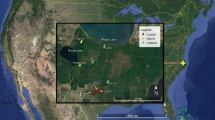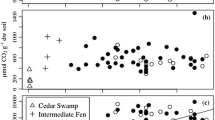Abstract
Under the warmer climate, predicted for the future, northern peatlands are expected to become drier. This drying will lower the water table and likely result in reduced emissions of methane (CH4) from these ecosystems. However, the prediction of declining CH4 fluxes does not consider the potential effects of ecological succession, particularly the invasion of sedges into currently wet sites (open water pools, low lawns). The goal of this study was to characterize the relationship between the presence of sedges in peatlands and CH4 efflux under natural conditions and under a climate change simulation (drained peatland). Methane fluxes, gross ecosystem production, and dissolved pore water CH4 concentrations were measured and a vegetation survey was conducted in a natural and drained peatland near St. Charles-de-Bellechasse, Quebec, Canada, in the summer of 2003. Each peatland also had plots where the sedges had been removed by clipping. Sedges were larger, more dominant, and more productive at the drained peatland site. The natural peatland had higher CH4 fluxes than the drained peatland, indicating that drainage was a significant control on CH4 flux. Methane flux was higher from plots with sedges than from plots where sedges had been removed at the natural peatland site, whereas the opposite case was observed at the drained peatland site. These results suggest that CH4 flux was enhanced by sedges at the natural peatland site and attenuated by sedges at the drained peatland site. However, the attenuation of CH4 flux due to sedges at the drained site was reduced in wetter periods. This finding suggests that CH4 flux could be decreased in the event of climate warming due to the greater depth to the water table, and that sedges colonizing these areas could further attenuate CH4 fluxes during dry periods. However, during wet periods, the sedges may cause CH4 fluxes to be higher than is currently predicted for climate change scenarios.






Similar content being viewed by others
References
Bellisario LM, Bubier JL, Moore TR, Chanton JP. 1999. Controls on CH4 emissions from a northern peatland. Global Biogeochem Cycles. 13:81–91
Campbell DR, Duthie HC, Warner BG. 1997. Post-glacial development of a kettle-hole peatland in southern Ontario. Ecoscience. 4:404–18
Chanton JP, Dacey JWH. 1991. Effects of vegetation on methane flux, reservoirs, and carbon isotopic composition. In: Sharkley TD, Holland EA, Mooney HA, Eds. Trace gas emissions by plants. Toronto: Academic Press. p 64–92
Christensen TR, Cox P. 1995. Response of methane emission from arctic tundra to climate change: results from a model simulation. Tellus 47B:301–309
Christensen TR, Jonasson S, Callaghan TV, Havström M. 1999. On the potential CO2 release from tundra soils in a changing climate. Appl. Soil Ecol 11:127–134
Christensen TR, Ekberg A, Ström L, Mastepanov M, Panikov N, Öquist M, Svensson BH, and others. 2003. Factors controlling large scale variations in methane emissions from wetlands. Geophys Res Lett. 30:1414. DOI: 10.10.29/2002GL016848
Ding W, Cai Z, Tsuruta H. 2004. Diel variation in methane emission from the stands of Carex lasiocarpa and Deyeuxia angustifolia in a cool temperate freshwater marsh. Atmospheric Environment. 38:181–188
Environment Canada. 2004. Canadian climate normals 1971–2000. [Online]. URL: http://www.climate.weatheroffice.ec.gc.ca/climate_normals/results_e.html (2004, Mar. 29)
Gorham E. 1991. Northern peatlands: role in the carbon cycle and probable responses to climatic warming. Ecol Appl 1(2):182–195
Ioffe BV, Vitenberg AG. 1982. Head-space analysis and related methods in gas chromatography, New York: Wiley-Interscience
Joabsson A, Christensen TR, Wallén B. 1999. Vascular plant naturals on methane emissions from northern peatforming wetlands. Trends Ecol Evol 14(10):385–388
Kelker D, Chanton J. 1997. The effect of clipping on methane emissions from Carex. Biogeochemistry 39:37–44
Kellner E, Halldin S. 2002. Water budget and surface-layer water storage in a Sphagnum bog in central Sweden. Hydrol Process 16:87–103
Lloyd D, Thomas KL, Benstead J, Davies KL, Lloyd SH, Arah JRM, Stephens KD. 1998. Methanogenesis and CO2 exchange in an ombrotrophic peat bog. Atmos Environ 32(19):3229–38
MacDonald JA, Fowler D, Hargreaves KJ, Skiba U, Leith ID, Murray MB. 1998. Methane emission rates from a northern wetland: response to temperature, water table and transport. Atmospheric Environment. 32:3219–27
Mitchell JFB. 1989. The “greenhouse” effect and climate change. Rev Geophys 27(1):115–39
Moore PD. 2002. The future of cool temperate bogs. Environ Conserv 29(1):3–20
Moore TR, Roulet NT, Waddington JM. 1998. Uncertainty in predicting the effect of climatic change on the carbon cycling of Canadian peatlands. Clim Change 40:229–45.
Popp TJ, Chanton JP, Whiting GJ, Grant N. 2000. Evaluation of methane oxidation in the rhizosphere of a Carex dominated fen in north central Alberta, Canada. Biogeochemistry 51:259–281.
Price JS. 2003. Role and character of seasonal peat soil deformation on the hydrology of undisturbed and cutover peatlands. Water Resour Res 39:1241. DOI: 10.1029/2002WR001302
Price JS, Schlotzhauer SM. 1999. Importance of shrinkage and compression in determining water storage changes in peat: the case of a mined peatland. Hydrol Process 13:2591–601
Roulet N, Moore T, Bubier J, Lafleur P. 1992. Northern fens: methane flux and climatic change. Tellus 44B:100–5
Schimel JP. 1995. Plant transport and methane production as naturals on methane flux from arctic wet meadow tundra. Biogeochemistry 28:183–200
Schütz H, Schröder P, Rennenberg H. 1991. Role of plants in regulating the methane flux to the atmosphere. In: Sharkley TD, Holland EA, Mooney HA, Eds. Trace Gas Emissions by Plants. Toronto: Academic Press. p 29–63
Shannon RD, White JR, Lawson JE, Gilmour BS. 1996. Methane efflux from emergent vegetation in peatlands. J Ecol 84:239–246
Southall EJ, Dale MP, Kent M. 2003. Spatial and temporal analysis of vegetation mosaics for conservation: Poor fen communities in a Cornish valley mire. J Biogeogr 30:1427–1443
Strack M, Waddington JM, Tuittila E-S. 2004. The effect of water table drawdown on northern peatland methane dynamics: implications for climate change. Global Biogeochem Cycles 18:GB4003. DOI: 10:1029/2003GB002209
Waddington JM, Roulet NT, Swanson RV. 1996. Water table natural of CH4 emission enhancement by vascular plants in boreal peatlands. J Geophys Res 101(D17):22775–85
Waddington JM, Griffis TJ, Rouse WR. 1998. Northern Canadian wetlands: net ecosystem CO2 exchange and climatic change. Clim Change 40:267–75
Acknowledgements
This research was supported by a Discovery Grant from the National Science and Engineering Research Council of Canada (NSERC) and a Canadian Foundation for Climate and Atmospheric Sciences grant to J.M.W. and an NSERC Canada Graduate Scholarship to M.S. A special thanks to Les Tourbes Nirom Peat Moss Inc. for use of the study site. We are grateful to Bronwyn Findlay, Claudia St. Arnaud, J. R. van Haarlem, Katy Shaw, Marie Dubois, and Pete Whittington for assistance in the field and to Melissa Greenwood for lab assistance. Several anonymous reviewers provided insightful comments that greatly improved this paper.
Author information
Authors and Affiliations
Corresponding author
Rights and permissions
About this article
Cite this article
Strack, M., Waller, M.F. & Waddington, J.M. Sedge Succession and Peatland Methane Dynamics: A Potential Feedback to Climate Change. Ecosystems 9, 278–287 (2006). https://doi.org/10.1007/s10021-005-0070-1
Received:
Accepted:
Published:
Issue Date:
DOI: https://doi.org/10.1007/s10021-005-0070-1




